We are aware that choosing between saltwater and freshwater trolling motors might seem straightforward, but it's not just about the water you'll be fishing in. As fellow anglers, we recognize it's important to evaluate other factors that could affect your decision. Have we pondered the motor's construction and how it impacts long-term maintenance? With so much at stake, getting the wrong motor could cost more in repairs than the initial price tag. Let's explore what truly makes a trolling motor suited for either environment, ensuring our fishing trips remain smooth and hassle-free.
Understanding Trolling Motor Basics
When choosing the best trolling motor for your fishing setup, it's crucial to understand the variety of options available. Whether you've got a small jon boat or a bass boat, the right motor will make or break your fishing experience.
Let's delve into steering mechanisms and how they enhance our user experience. We can go with a tiller steer option, which offers straightforward handling through simple clockwise and counter-clockwise movements. It's all about that personal touch, giving us the control we crave. Additionally, it's important to note that in freshwater environments, the battery life of your motor can be extended by operating at slower speeds.
For those who want more advanced control, digitally controlled trolling motors bring the future to our fingertips. With handheld remotes or even smartphone apps, we're able to steer the boat and adjust speed with ease.
Imagine the freedom of moving hands-free with a wireless remote while you cast your line.
And for the traditionalists among us, foot-control motors provide steering with two cables, allowing tight maneuverability common in bow-mounted motors. It gives us precise control without taking our hands off the action.
Each choice shapes our adventure, enhancing our experience while we chase the perfect catch, ensuring we enjoy every moment on the water.
Key Differences in Motor Construction
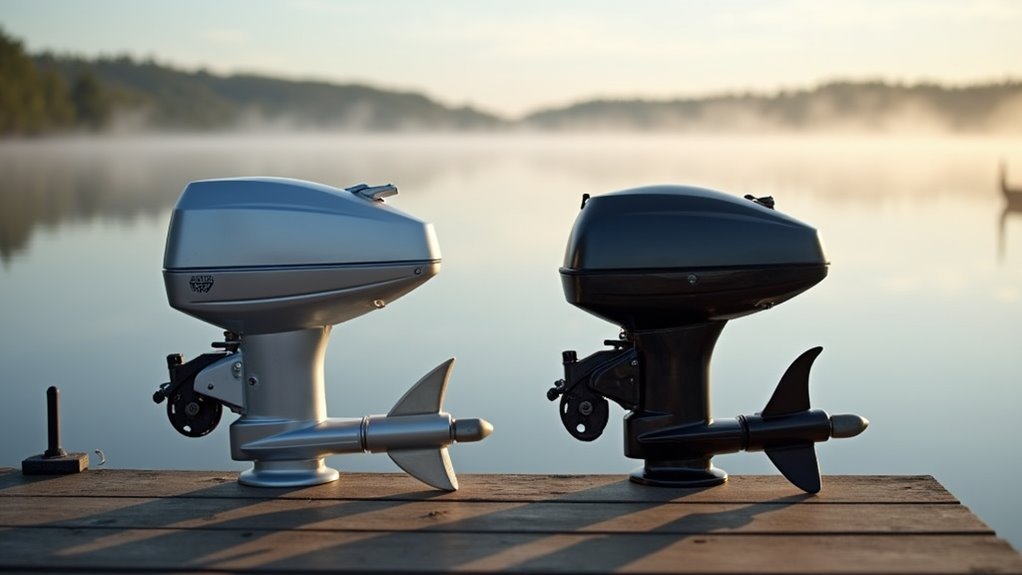
Having explored the various steering mechanisms for trolling motors, we now focus on their construction differences that influence performance and durability. It's important to ponder material selection and design adaptations, which play vital roles in determining how these motors fare in different environments.
For freshwater trolling motors, we typically see the use of aluminum and zinc alloys. These materials are perfectly suited for calmer waters. Additionally, freshwater motors tend to be more budget-friendly than their saltwater counterparts due to their simpler construction.
In contrast, saltwater motors are designed with stainless steel hardware, featuring sealed electrical connections and specialized coatings. This careful choice of materials helps them withstand the harsh, salty conditions they face.
Design adaptations are also essential when looking at these motors. Freshwater motors have a simpler design, tailored for tranquil environments.
However, saltwater motors boast advanced features like multiple speed settings, GPS, and digital anchoring. These adaptations allow them to handle strong currents and winds with ease.
In terms of maintenance, freshwater motors are less demanding, requiring only periodic checks.
Saltwater motors, however, need more attention to guarantee longevity. Routine inspections, frequent fresh-water rinses, and protective coating checks are necessary for them to keep performing well, making them a more reliable option for challenging conditions.
Power Requirements and Efficiency
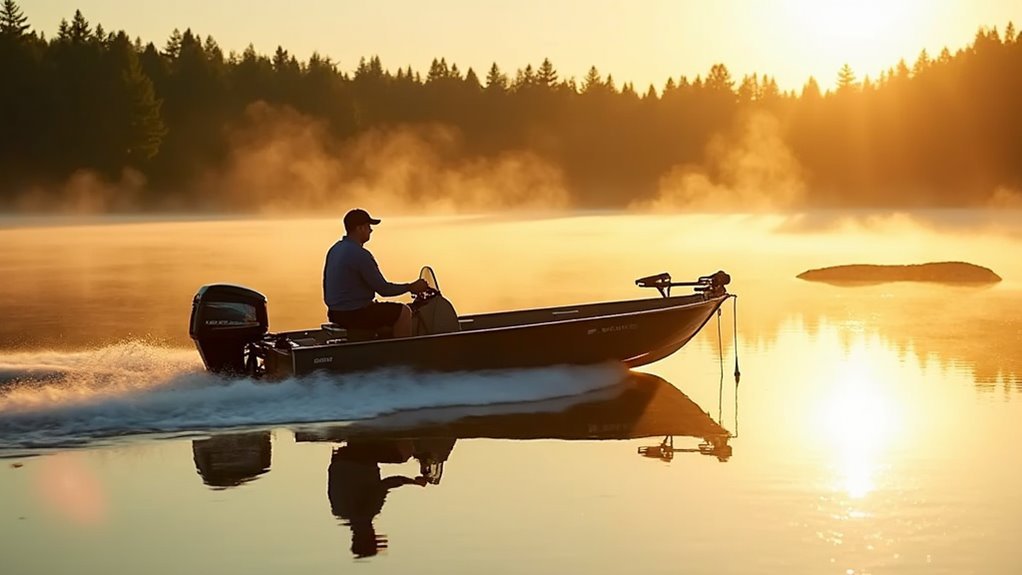
Understanding the power requirements and efficiency of trolling motors is essential for tailoring our fishing experience to either freshwater or saltwater environments. There's a unique thrill in traversing these waters with the right setup, and for that, a precise thrust calculation becomes vital.
In freshwater, our boat's size and weight determine the minimum thrust needed—typically 2 pounds for every 100 pounds. Imagine a 3000-pound boat requiring about 60 pounds of thrust, though for peak performance in strong conditions, it could really shine with 70-80 pounds. Considering the environmental conditions, such as wind and current, is crucial as they can alter the necessary thrust for optimal maneuverability.
When it comes to voltage efficiency, smaller freshwater boats are paired well with 12-volt batteries, while larger vessels benefit from 24-volt or even 36-volt systems. A higher voltage means less amp draw, giving us longer playtime on the water without constantly worrying about battery life.
Choosing the right voltage pairs well with deep-cycle marine batteries for durability.
In saltwater, where conditions are often rougher, higher thrust is key—maybe 70-100 pounds for medium to large boats. Ensuring our motor's voltage efficiency aligns with these needs helps us traverse the undulating waves with ease, making every fishing trip a masterpiece of control and adventure.
Corrosion Resistance and Durability
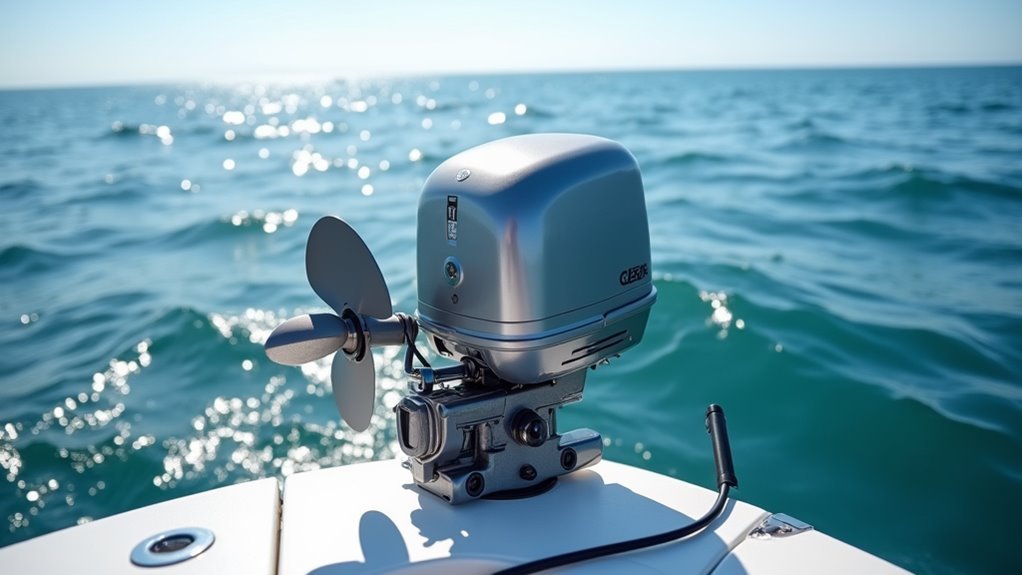
As we consider the power requirements for our trolling motors, it's important to also think about their ability to withstand the elements, especially in saltwater environments. The harshness of saltwater can easily cause corrosion if we're not prepared. Furthermore, saltwater trolling motors generally require more power due to the denser environment, ensuring they are equipped to handle increased thrust demands. Choosing the right materials for our trolling motor is like suiting up for a battle with the sea. Stainless steel, sealed connections, and sacrificial anodes are essential. These help keep our motors running smoothly and guarantee that freedom to fish whenever we want. Let's highlight some of the key corrosion-fighting strategies that keep our motors from rusting out:
- Material selection that's made for saltwater like stainless steel guarantees long-term durability.
- Coating technologies such as anodized aluminum and epoxy paints further shield against rust.
- Sacrificial nodes act as heroes, corroding instead of our motor's essential parts.
Saltwater is more corrosive due to higher salinity and harsh conditions, so our motors are designed for durability. If we want to continue casting out into the open seas, choosing a motor that withstands these elements is critical.
Maintenance and Longevity Tips
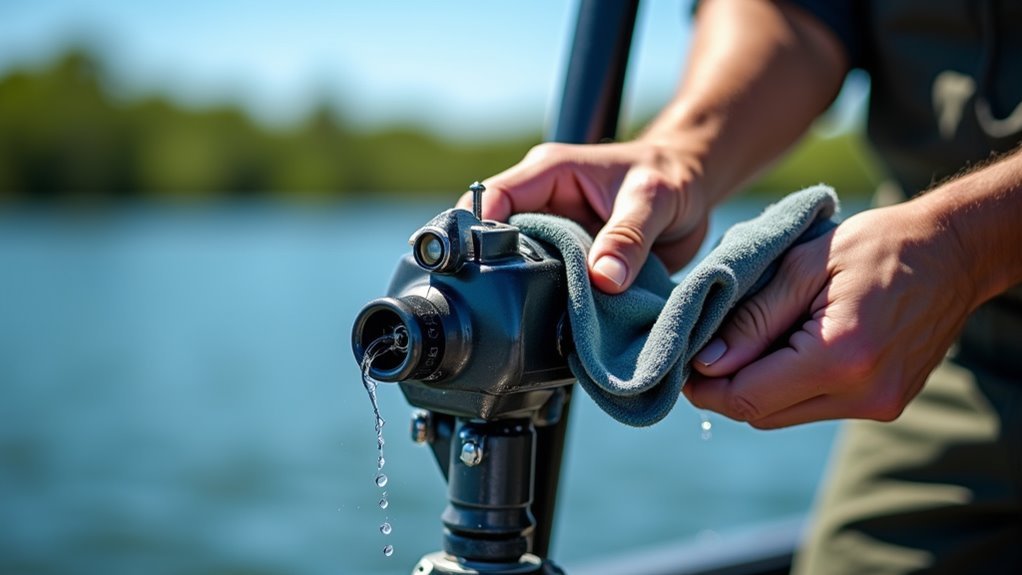
Proper maintenance is essential to extending the life of our trolling motors. We all want the freedom to fish whenever and wherever without worrying about our equipment failing.
To guarantee this, let's follow a few simple maintenance steps. After a day out, especially in salty or brackish water, regular rinsing with fresh water is a must. But remember, avoid blasting the cap on the motor shaft with strong water jets. Instead, use a gentle spray. It's also crucial to perform a biannual inspection of the plunger actuator and latch cam pin sensor to ensure they're functioning properly.
Applying a water-based silicone spray is another critical step. It keeps the motor shaft and moving parts free from corrosion and guarantees everything moves smoothly.
Also, inspecting the mechanical areas for debris is necessary. Look at places like the steering housing and motor ramps.
Of course, we shouldn't forget about the batteries. Let's inspect and test our batteries regularly, at least twice a fishing season. Check the wiring too.
Our propeller needs attention as well. Removing it to check for trapped weeds or fishing line is a habit we should cultivate.
Finally, storing our motors properly when they're not in use is important to prevent damage. By following these tips, we'll enjoy longer, trouble-free fishing adventures.
Selecting the Right Thrust Level
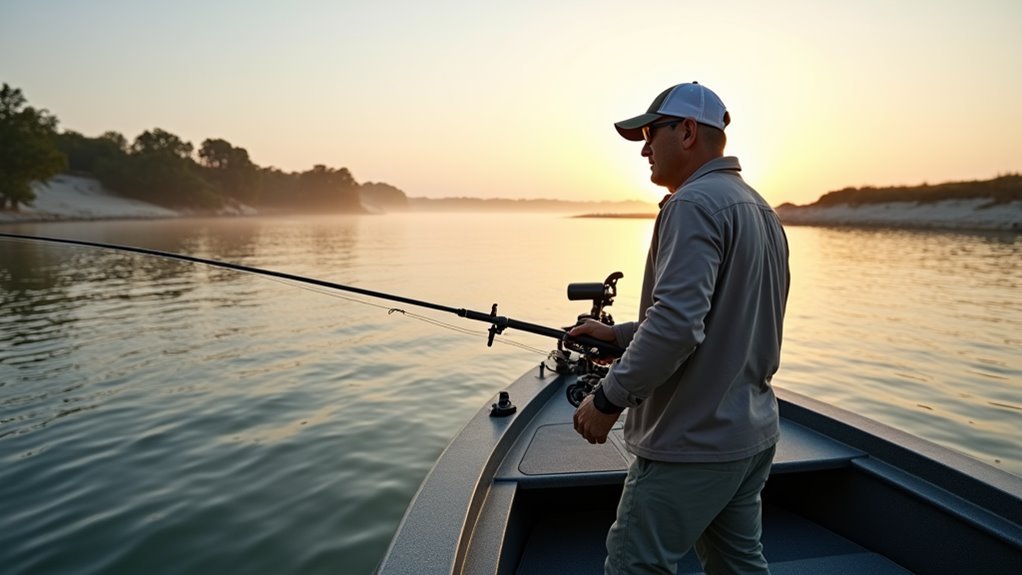
Now that we've covered ways to maintain our trolling motors for maximum longevity, let's focus on selecting the right thrust level to enhance our fishing trips. When we're out on the water, the right thrust level is vital for steering comfortably and confidently, especially with varying environmental factors and load variations.
The thrust level we choose hinges on several factors including the boat's weight and hull type. A trolling motor's power is measured in pounds of thrust, which is essential to consider when determining the appropriate force needed for your vessel.
To make sure we're on point, keep these key ideas in mind:
- Thrust Calculation: Use the standard rule: 2 lbs of thrust for every 100 lbs of boat weight, including your load. This guarantees we've enough power to handle whatever the day throws at us.
- Voltage Variety: Trolling motors come in different voltages (12v, 24v, 36v). Higher voltages mean more thrust, and consequently, more freedom to roam with ease.
- Hull Design: Different hulls, like Deep V or pontoon, need extra thrust to combat drag and wind.
With these insights, we can choose motors that offer enough power to tackle wind, current, and allow a smooth cruising speed, guaranteeing a worry-free fishing adventure.
Cost and Budget Considerations
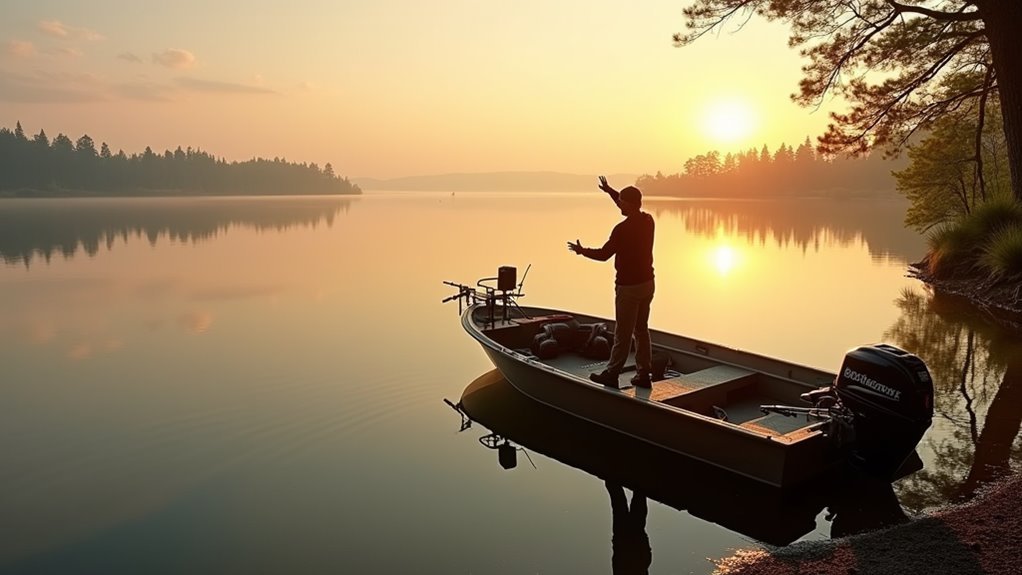
When choosing a trolling motor, we need to take into account our budget and the various costs that come into play. Budget planning is vital, whether we're into serious saltwater fishing or just enjoying a relaxed day on a freshwater lake.
A thorough cost analysis shows that saltwater motors, with their corrosion-resistant materials and advanced features, are typically more expensive. They're designed to handle tough conditions, which adds to their cost. Saltwater motors like the Minn Kota Riptide Instinct Quest offer reliable protection against harsh marine environments, thanks to advanced corrosion protection. For some, the price is justified by longevity and performance, but it's important to weigh these factors.
For those of us with tighter purses, there are budget-friendly options like the Minn Kota Riptide Maxxum or the Newport Vessels Edge, which balance price and performance without the fancy extras. Manual operation and lower thrust models can save money, though they might lack some conveniences.
Long-term considerations also play a part. Saltwater motors might have a higher upfront price, but durable materials and battery efficiency can lead to savings over time. And, don't forget resale value—premium models like Garmin Force often hold value, making them smart investments for serious anglers. Balancing our immediate costs with these long-term benefits is key to wise money choices.
Frequently Asked Questions
Do Freshwater Trolling Motors Harm Marine Ecosystems When Used in Saltwater?
We must recognize that using freshwater trolling motors in saltwater poses corrosion risks and can cause electrical interference. This harms marine ecosystems. By opting for proper equipment and maintenance, we protect nature and enhance our fishing adventures.
Are There Eco-Friendly Trolling Motor Options for Environmentally Conscious Anglers?
Let's ride the wave of change with eco-friendly trolling motors. They're crafted with sustainable materials and boast eco certifications. Together, we'll preserve our waters, ensuring the freedom to explore nature without compromising the environment.
Can a Used Trolling Motor Perform as Well as a New One?
We can't deny that new motors generally outperform used ones due to enhanced technology and efficiency. When considering longevity and maintenance costs, investing in a new motor typically grants us more freedom and fewer worries on the water.
What Impact Do Trolling Motors Have on Fishing Success Rates?
Trolling motors can dramatically influence fishing success rates. We need to adopt various fishing tactics and prioritize motor efficiency. With the right gear, we're flexible and free to explore vast areas, optimizing our catch and adventure experiences.
How Do Weather Conditions Affect Trolling Motor Performance?
We've faced winds fierce as dragons, but weather changes like wind resistance and water clarity can challenge our trolling motors' performance. Adapting engine power and propeller settings guarantees we maintain our sailing freedom, despite nature's whims.
Conclusion
So, when we're out there trying to decide between saltwater and freshwater trolling motors, it's like picking the right tool for the job, isn't it? Saltwater motors, with their rugged builds, are what we need to tackle the ocean's tricky conditions, while freshwater motors offer simplicity and ease for lake adventures. Let's remember, choosing wisely guarantees our gear lasts and performs, keeping our fishing trips smooth and enjoyable for years to come. Happy fishing, everyone